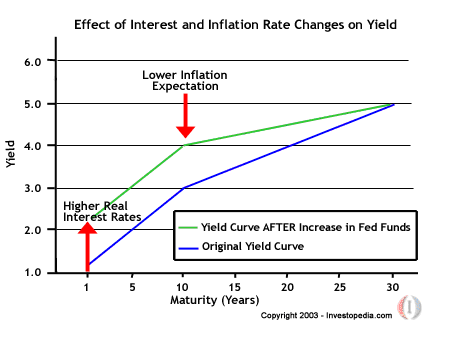



The normal yield curve is upwards sloping because long-term bonds are more risky than short-term bonds and investors expect to be compensated with higher yields. Steepness is also an important consideration. If the below curve was steeper it would likely be because investors believe the economy will grow very quickly such as at the beginning of an economic expansion following a recession.
A steep
curve can occur when the small percentage gap between the
shortest maturity bonds (i.e. three-month T-bills) and the longest
maturity bonds (i.e. 30-year Treasury bonds) widens because some economic
force causes the short-term rates to drop more than long-term ones. A
steep curve often forecasts a faster-growing economy because lower
short-term rates make it easier for companies to borrow money to expand
their operations.
In reality the yield curve can take on many shapes.
¡@
A hump-backed yield curve is a combination of each of the shapes above and like the flat yield curve can be interpreted as indicating a transitionary phase. The hump can be above short and long rates or can be a dip below them.
The British pound yield curve on February 9, 2005. This curve is unusual (inverted) in that long-term rates are lower than short-term ones.
Inverted curves are rare and reflect an expectation that inflation will be subdued in the future and often implies an impending recession.
10000 for EEC (at Greece event)
1300y for Ireland
2000y for Greece
?? 3000y for Portugal
total: 6300 y
available: 3700y (if Spain needed)
?? another 1000y
¡@
¡@
¡@





